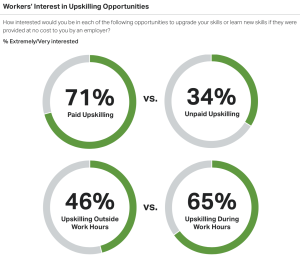Whatever your view about the likely impact of developments in technology and AI on jobs (estimates suggest 10-20% of Americans currently have jobs most likely to be impacted by AI), there’s one thing that is definitely going to change: employees’ future skill requirements.
Frighteningly, research predicts that as many as half (48%) of the skills that exist in today’s workforce won’t be relevant just two years from now – all thanks to the spread of artificial intelligence. [Research by edX].
But the great unknown in all of this is less whether jobs are going to be eviscerated altogether, and more whether people are either going to have to change what they do entirely, or get better at what they already do – in other words, whether staff need to re-skill or up-skill themselves respectively.
It’s the next business-critical decision
The extent to which employers think they’ll need to up-skill vs re-skill their staff is going to be one of the most important ones business leaders are going to make.
If re-skilling is defined a talent management approach that involves identifying employees working in jobs for which the organization has declining demand – and then training them up to take on jobs for which the organization has a growing need – the direction organizations take will literally determine their entire future success.
By comparison, up-skilling, is training that helps employees continue to perform well in their current role.
It is probable that businesses will need to do a bit of both, and so it’s a decision they will ultimately want to get right.
But how do CHROs even begin the decide on the proportions they devote to each type of learning, especially when each organization is so vastly different, and comparisons can be hard to make?
Percentage of spend on re-skilling
Well, just recently, Texas-based benchmarking company, APQC, sought to try and answer this.

It found that ‘median’ performing organizations typically devoted around a quarter of their learning budgets on re-skilling (rather than up-skilling), workers for new technologies (above).
By comparison, at 75 percentile organizations, the amount is much higher.
Here, around 40% of its learning budget (or more) was set aside for re-skilling aligned to new technologies.
Low performing organizations (those at the 25th percentile), only designated 15% of their learning budgets to re-skilling.
But while this might all sound logical, can it really be applied to all businesses – especially when the same edX research also finds organizations plan to eliminate more than half (56%) of entry-level knowledge worker roles because of AI?
It’s worth remembering that in addition to this, 79% of executives predict entry-level knowledge worker jobs will no longer exist at all, as AI creates an entirely new suite of roles for employees entering the workforce.
So again, are people needing up-skilling, so they can transition into new roles, or do they need re-skilling for entirely different jobs altogether?
To help answer some of these questions, TLNT spoke exclusively to Dan Hayward, CCO at learning platform-provider, Go1.
Dan argues what CHROs really need to do is get their heads around another skilling term: ‘pre-skilling’.
This, he argues, describes the process of starting to give staff access to learning that the don’t immediately need, but may do as jobs/technology evolve:
Q: OK, we’ve heard about re-skilling and up-skilling, so talk to me about ‘pre-skilling’:
A: “To me, pre-skilling feels more like an emerging trend. People are either disengaged, or they feel at risk of being replaced, and they want to feel like they can ‘grow’ into a role and develop in that way. The problem with L&D consistently focusing on skills, is that it creates a sort of paralysis, around how to get things right when things are constantly changing. Pre-skilling is more about creating a ‘culture of learning’ – where people can develop some of the broad skills they might need in the future, in advance. These are skills like critical thinking, greater collaboration, EQ, that sort of thing. These are skills that are hard for people to get if they’re always on zoom calls, and so they do need to be deliberately pursued.”
Q: What makes pre-skilling different to up-skilling?
A: “Pre-skilling isn’t up-skilling. Pre-skilling is more pre-wiring agility into an organization – about getting people comfortable with learning. Up-skilling is more around short-mid-term skills needs that might be needed, and working back from that. Pre-skilling is more generic, and sits a bit more regardless of where the exact skills needs of an organization are. We talk a lot about required vs desired vs inspired learning. I think pre-skilling sits more in the inspired space – creating connections, where people feel a passion for learning.”
Q: Who’s driving demand for pre-skilling – is it employees themselves, or employers?
A: “It’s quite clear to me that employees are becoming more and more aware of the need to learn, to future-proof themselves. But I also think they understand that in many organizations there is a mismatch with traditional learning. There is definitely a fear-factor from staff – of a need to stay current though. Learning trends are often cyclical – in the 1990s it felt like everything was to do with future skills. Now though, organizations are more short-term, and so they need to think how their learning strategy fits that model.”
Q: Is the problem with pre-skilling, that the ROI is even more difficult to measure that standard learning, and difficult for CHROs to ‘sell’ to the board?
A: “ROI always tends to be the key conversation. The skill is how CHROs convert worries about near-term goals, and how this can be morphed into a proper learning culture. Micro-learning is one of the modalities that CHROs can use: ie short, sharp learning for a specific problem, or when someone needs a quick boost/reminder. Younger people are certainly much more inclined towards wanting micro-learning.”
Q: I’ve heard you mention ‘pathways to learning’ in the past – is this the main thing employers need to create?
A: “Yes. Ease of access is what makes people want to dip into training repeatedly. Organizations need to be able to facilitate a way of doing this – for instance making learning searchable, according to length, skills, etc. When people start taking learning, a good LMS will then make suggestions for staff about other learning they might be interested in, based on what they’ve already done. This is when learning becomes a virtuous circle. We have to remember that surveys consistently say that 40% of GenZ want to quit where they currently work because of lack of career development. Organizations just have to jump the gap that makes people feel inspired to learn.”
Up-skilling motivations:
In 2021 Gallup/Amazon interviewed more than 15,000 US workers about their attitudes to up-skilling – long before AI was in regular conversations.
At a time when many were being laid off due to Covid-19 though, it was revealed that:
- 63% of laid off workers said they are “extremely” or “very” interested in up-skilling
- 71% of workers would be interested in some form of up-skilling
- Up-skilling demand is linked to perceived job opportunities as well as job threats: Some 54% of people in computer and mathematical-related jobs (where there are 10 vacancies for each unemployed worker), say they have participated in an employer-provided up-skilling program. By contrast, only 19% of those in food service and preparation occupations (where there is less than one vacancy for every unemployed worker) attended an employer-provided up-skilling program.
- 30% of workers saying they were able to move into a new, higher paying job after up-skilling.
- Workers have higher engagement at work when they have participated in some form of up-skilling



Source: Amazon/Gallup’s ‘The American Up-skilling Study’
